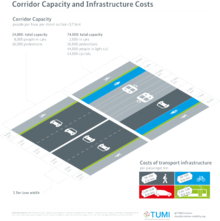This article has multiple issues. Please help improve it or discuss these issues on the talk page. (Learn how and when to remove these messages)
|
The iceberg transport cost model is a commonly used, simple economic model of transportation costs. It relates transport costs linearly with distance, and pays these costs by extracting from the arriving volume. The model is attributed to Paul Samuelson's 1954 article in Deardorffs' Glossary of International Economics.[1] Paul Krugman's 1991 paper on Economic Geography[2] is one of the more widely cited papers employing the model.

The metaphor is that an iceberg melts when transported, so only a fraction of the starting amount arrives at the destination. And a smaller amount arrives if the distance traveled is longer. A more realistic idea might be an oil tanker that uses up its oil based on the distance it travels.
References
edit- ^ Alan Deardorff's Glossary of International Economics
- ^ Krugman, Paul(1991) "Increasing returns and economic geography". Journal of Political Economy Vol. 99, No.3 (June 1991)
External links
edit- Krugman, Paul(1991) 'Increasing returns and economic geography'. Journal of Political Economy Vol. 99, No. 3 (Jun., 1991), pp. 483–99.
- Krugman, Paul (1991). "Increasing returns and economic geography". Journal of Political Economy. 99 (3): 483–499. CiteSeerX 10.1.1.322.8325. doi:10.1086/261763.
- McCann, Philip (2005). "Transport costs and new economic geography". Journal of Economic Geography. 5 (3): 305–316. doi:10.1093/jnlecg/lbh050.
- Samuelson, Paul (1954). "The Transfer Problem and Transport Costs, II: Analysis of Effects of Trade Impediments". Economic Journal. 64 (254): 264–289. doi:10.2307/2226834. JSTOR 2226834.
- Maarten Bosker, Eltjo Buringh. 2020. "Ice(berg) Transport Costs." The Economic Journal.